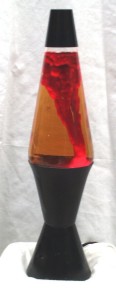

WARNING – Use at your own risk! We cannot guarantee the accuracy or the safety of these activities. Some of these activities are far more dangerous than others. The contributors and Bradley University do not assume any responsibility for these activities or their results. If you have questions, corrections, or comments please do not hesitate to contact Dean Campbell (campbell@bumail.bradley.edu) at Bradley University.


A Real "Lava" Lamp
This lamp was purchased, not homemade. You can see our version of the lava lamp below.



A Homemade "Lava" Lamp
We set out to find a perfect homemade recipe that could be
used in the lab to illustrate a variety of physical and chemical
properties such as convection, solubility, surface tension, thermal
expansion and density. After searching the net for recipes, we
tried a mixture of mineral oil (lava) and isopropyl alcohol. This
gave us reasonable results, but the isopropyl alcohol evaporates
quickly and with heating it evaporates even more quickly. So,
we tried the mixture shown above. It is a saturated sodium chloride/water
solution with silicone oil as the lava. We used iodine to tint
the silicone oil purple. A 60 watt light bulb was used to heat
the solution, and a wire coil from a heating element was placed
in the bottom of the beaker to help break the surface tension
of the silicone oil so new blobs can form. As the light bulb heats
the silicone oil, the density of the oil becomes less than the
salt water and the oil rises to the top. We shielded the top of
the beaker from the light to keep a temperature differential so
that the lava would cool and become more dense. The density of
the silicone oil becomes greater than the salt water and the silicone
oil sinks. When picking ingredients, the densities need to be
similar, and the coefficient of thermal expansion for the lava
should be high relative to the surrounding liquid. Ideally, the
mixture should be placed in a sealed container to prevent evaporation.
Another homemade recipie and a bit of lava lamp history can be
found at: www.oozinggoo.com
BELOW: A homemade lava lamp.

More history of lava lamps can be found at:
www.straightdope.com/classics/a2_359.html
www.uspto.gov/patft/index.html (you can see the original US patent (#3387396) through this search engine)
More lava lamp links can be found at:
www.lavalites.com
www.lavaworld.com
www.mathmos.co.uk
Return to Dr. Campbell's Favorite Demonstrations
Last updated 1/17/12
Site created at the laboratory of Dean Campbell